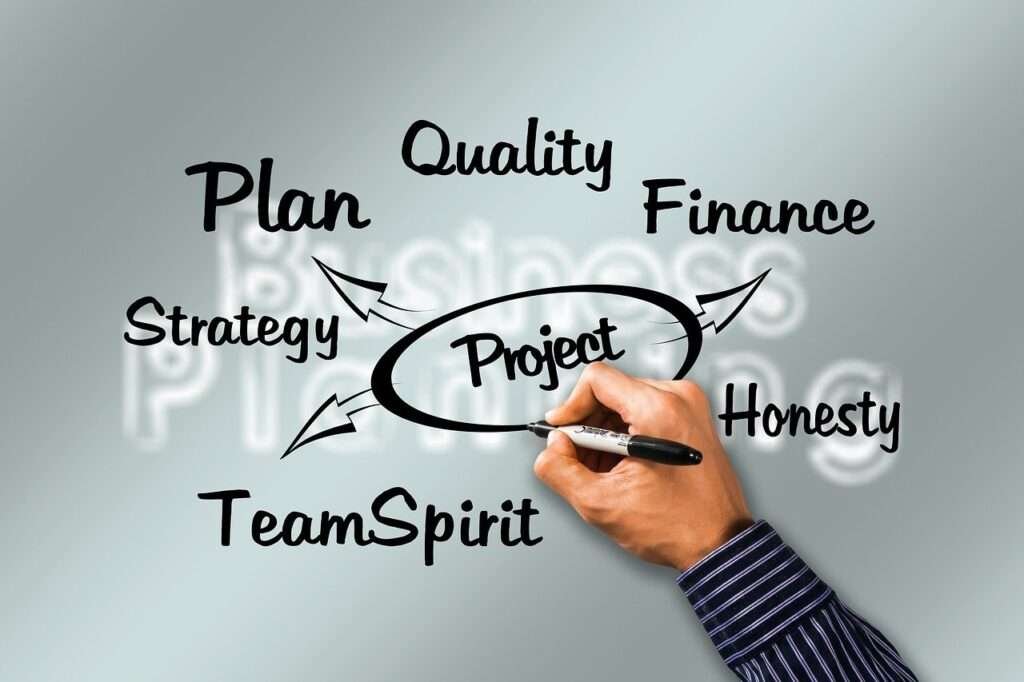How to lead a Change Management Project effectively.
Change is unavoidable in any organisation and the
rules of both change management and project management must apply to ensure
success.
It is your responsibility as a leader to guide
your team through the process of change management and ensure successful
project delivery within scope, time and budget using project management tools.
Change management and project management are two
distinct but interconnected functions in getting the job done.
Fostering effective team collaboration is a
critical component of successful change implementation and overall project
success.
When your team works more effectively,
collaboratively, and cohesively, they are better prepared to face the
challenges and opportunities that come with change.
As a leader, your actions always speak louder than
your words. With that in mind, model the behaviour you want to see from your
team members.
Showcase active collaboration, effective
communication, and a willingness to embrace change. Lead by example, and
hopefully your team will follow suit.
Today I thought we should look at some good ways
to lead your team through successful change management.
I’d like to kick things off though by looking at
why most large scale change management projects might fail.
The Challenge of Large Scale Changes in Business.

Large-scale change initiatives pose particular difficulties and can be a horrible mess at the start.
These sometimes massive initiatives entail substantial adjustments that affect several if not all departments, most of your current procedures, and even the corporate culture.
Sadly, a lot of these initiatives fall short of the goals they set out to accomplish.
With this in mind, what are some of the most common causes of this?
Avoid Lacking Leadership Support and Engagement at all costs.
A major contributing factor to the failure of large-scale change initiatives is the absence of involvement and support from upper management.
Executives can sometimes go missing when employee resistance or apprehension about the proposed changes arises in the absence of strong leadership support for the change.
To inspire confidence and commitment from the entire organisation, executives and sectional leaders should actively communicate the need for this change, address concerns that arise, and actively participate in the change process, even when it starts to get messy.
Communicate and Engage with Key Stakeholders.
A key component of successful change management is effective communication. Employees, managers, and external contractors, consultants and project partners are among the many stakeholders involved in large-scale change initiatives.
Project failure may result from miscommunication, lack of communication, disapproval and misunderstandings if these stakeholders are not involved and communicated with.
Establish a well-defined communication strategy, give frequent updates, and respond to all concerns and inputs if you want the project to be successful.
Insufficient Proper Planning and Preparation will hurt the project.
Large-scale change initiatives require careful preparation and advance planning. In the absence of a well-thought-out and approved plan, organisations might encounter unforeseen difficulties and setbacks.
It’s critical to carry out a thorough analysis of the current situation, establish precise goals and objectives, and create a comprehensive change process roadmap.
Make sure that there’s plenty in the budget and sufficient personnel allocated to support the project over its entirety.
The levels of support may also need to change (can go up and down) at certain project milestones, so this must be planned ahead of time.
Some Resistance to Change is to be expected & that’s ok.
A common obstacle in any change management endeavour is resistance to change. This resistance may be heightened in large-scale projects because of the size and significance of the changes.
Workers at ‘the coal face’ may be reluctant to leave their comfort zones because they perceive the proposed changes as a threat.
People may end up spending more time worrying about losing their jobs as a result of this change than working on the tasks associated with the change, and none of their fears are based on reality. All of which is waste and waste is never wanted on a large scale change management project.
To assist staff in navigating the change, it is critical to address these worries through very open communication, lots of training, and unwavering support.
Avoiding Employee Involvement and Buy-In is ridiculous.
It never ceases to amaze me just how many large scale change management projects get kicked off without ever involving people at the ground level.
It’s sad and disappointing to be on a site and witness a project falling apart and people not knowing what they are supposed to be doing more than one day in advance.
It’s increasingly disappointing when you ask just a few basic but searching questions and get a good lock on what’s probably the issue in just a couple of days.
Then, when you start discussing your ideas on what’s causing their problems and what could be done about it with the people most affected by the problems, you all too often get the response, “This is exactly what I was saying months ago but nobody wanted to listen!”
Change is nearly always going to be more successful when representatives from all levels employees are actively involved in the concept development, planning and preparation phases.
This makes sure that everyone has the opportunity to develop a sense of ownership in the upcoming process.
In large scale change projects, it is essential to involve employees from all different levels within the organisation with the early decision-making processes.
This not only helps generate innovative ideas using their vast specialised experience but also creates a sense of buy-in and commitment to the proposed changes and the vast scope of work that awaits them.
Never underestimate the importance of training and support.
Employees frequently need to pick up new skills and adjust to new procedures as a result of change.
Employee resistance and decreased productivity could result from their inability to adapt to the changes without the right assistance and training.
Large-scale change projects must succeed by offering thorough training programs, continued assistance (not just one-off set and forget assistance), and resources to help staff members adjust and stay on track.
Large scale change management is never easy.
Large-scale change management initiatives are challenging tasks that call for careful preparation, capable guidance, clear communication, and active staff participation.
Organisations can enhance the probability of success in their change initiatives by tackling common obstacles like inadequate communication, resistance to change, lack of employee involvement, inadequate planning, inadequate leadership support, and inadequate training.
A successful transformation can be facilitated by accepting change as a chance for improvement and incorporating all relevant parties in the process.
Typical ways of ensuring that your team is effective.
First and foremost, a leader should provide both positive and constructive feedback to their team members.
Sure, no one likes hearing that they’ve been on the wrong track, but if you can identify the need for ‘constructive feedback’ early on, it’s usually not as difficult for the recipient to digest.
Second, acknowledge team members’ accomplishments and provide feedback for improvement. Providing regular feedback promotes a culture of continuous improvement and collaboration.
Leading a change management project requires effective leadership and the ability to encourage team collaboration.
Implementing some solid people management strategies will assist you in creating a collaborative environment in which your team can work more efficiently, collaboratively, and cohesively.
What approach to take if the team is working less effectively together?
The approach I’d take would most likely depend on where we are in the project and when we have determined that the team is not working together effectively enough.
It would probably also depend on what type of project it was, after all, a project that involves building a new section of a highway is going to be ‘people managed’ a little differently to a project involving upgrading software.
One thing for sure is that fixing this type of problem would be much easier at the start than halfway through the planned project timeline.
Overall team effectiveness is frequently linked to overall collaboration and cohesiveness. Effectiveness, collaboration and cohesiveness are related concepts, but they have different meanings.
All three concepts contribute to the productivity and efficiency of a team, a cohesive team always stands out to me as it indicates there are emotional bonds and mutual commitment within the team.
Having a high level of cohesion in place will help make sure you get through the rough parts of a project without people ‘dropping their bundles’ when the going gets tough.
For my mind, group collaboration and cohesiveness are critical for the success of any project, and I would be tempted to take the time to understand why team members are struggling in these two areas, which should yield some significant benefits, as follows:
1. Investigating individual challenges aids in the identification of root causes.
2. Specific obstacles, such as communication gaps, personality clashes, or competing priorities, can be addressed directly.
3. A one-size-fits-all approach is rarely successful. Understanding each team member’s unique struggles enables you to tailor solutions.
4. For example, if someone lacks confidence in sharing their ideas, you can encourage them to participate more actively in meetings.
5. Taking the time to understand people’s struggles demonstrates empathy and genuine concern.
6. Trust grows when team members feel heard and supported, it’s then that they are more likely to collaborate openly.
7. Unresolved issues have the potential to escalate into larger problems in the future.
8. Addressing issues early on keeps conflicts from escalating and negatively impacting team dynamics.
9. A cohesive team is more efficient, innovative, and resilient.
10. Addressing individual struggles helps to create a healthier team environment.
11. Helping team members overcome obstacles promotes personal development.
12. It’s an opportunity to improve your skills, become more aware of yourself, and learn new things.
However, time management is crucial. While understanding individual struggles is important, avoid delving too deeply into the mysteries of the universe and becoming bogged down in analysis paralysis.
Allocate your time working out the kinks within your time wisely and make sure you don’t forgo other important leadership tasks along the way.
Focus on high-impact areas and have regular check-ins and open communication with the team to help to achieve a good balance.
Some useful strategies to foster a more collaborative, cohesive and overall effective team are:
1. Ensure that everyone understands the project’s overarching objective. When team members have a common goal, they are more likely to coordinate their efforts and collaborate effectively.
2. Clarify the project’s vision, mission, and desired outcomes. This clarity will help to break down silos and promote collaboration.
3. Establish clear guidelines for each team member’s role and responsibilities. Collaboration improves when everyone understands their specific responsibilities and how they contribute to the overall goal.
4. Encourage open communication about expectations, and solicit feedback to ensure alignment.
5. Team members can exchange ideas, share progress, and address challenges by holding frequent discussions. Regular check-ins with the team/teams encourages transparency and collaboration and cohesion.
6. Use these meetings to celebrate accomplishments, address challenges, and foster a sense of community.
7. Constructive feedback enables team members to improve their performance. When they work well together, acknowledge their contributions and give them positive feedback.
8. Recognise and celebrate team achievements. Having a win isn’t always easy, especially when the work is difficult, so recognise individuals who go above and beyond to help others in the process of securing a win.
9. Plan team-building activities to foster collaboration, trust, and communication. These exercises can be both enjoyable and useful, especially if you’ve noticed any signs of bitterness or distaste among the team members. The goal is to do these things at the appropriate frequency to avoid unpleasant feelings among the team members. In this space you might consider workshops or off-site retreats to help strengthen relationships and break down barriers.
10. Create a work environment in which team members feel free to express their opinions, share ideas, and take calculated risks, as trust is critical for successful collaboration.
11. Encourage open communication, active listening, and empathy. Avoid assigning blame or making judgements.
12. Use tools and platforms that make communication easier, such as project management software, in-house chat apps, expertise sharing and shared documents. This will help avoid instances of people spending time on re-inventing the wheel. That time will generally be wasteful and they’re going to be disappointed in the end.
13. Encourage team members to share information, ask questions, and seek assistance openly. Transparency prevents misunderstandings and encourages collaboration.
14. Define a team decision-making process, whether it is consensus-based, democratic, or led by a designated decision-maker; clarity on this topic promotes better collaboration. Involving relevant team members in a structured decision-making process increases ownership and commitment.
Remember that developing a collaborative team culture requires time and effort. As a project or change management leader, you play a critical role in promoting and reinforcing collaborative and cohesive behaviour.
Conclusion:
Implementing effective people management strategies can and should help you create more cohesive, collaborative, and effective teams that work towards a common goal or set of goals.
These types of teams are capable of tackling the large changes that must be successfully implemented.








